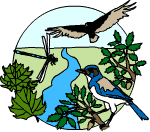 |
MISSION CREEK
TREES |
|
|
|
|
Aceraceae (Maple Family) |
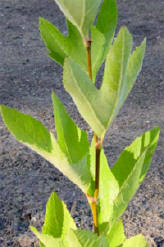 Box Elder Box Elder
Acer negundo
NATIVE
The box elder’s leaves
are coarsely serrated along margins in a somewhat lobed variable
shape. They are green above and paler green below and are arranged
opposite to each other. The yellowish green flowers appear after
the leaves come out in spring. Flowers are small, yellow, born in
long racemes. The double winged fruits, resembling helicopter
blades, are called samaras. |
|
Caprifoliaceae (Honeysuckle Family) |
|
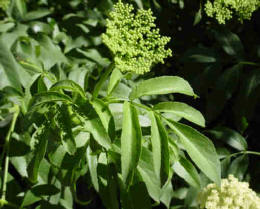 Blue Elderberry Blue Elderberry
Sambucus mexicana
NATIVE
Blue
elderberry prefers canyon bottoms where water is available in
summer, but also grows on dry hillsides. Elderberries often start as
multi-trunked shrubs that mature into small trees. The deciduous
leaves are compound. The blue berries are eaten by wildlife and
were dried for later use by the Ohlones. Early Californians made
jam and wine from the berries. The creamy flat-topped flower
clusters can be dipped in pancake batter and fried. Elderberry
stems have a soft white central pith that can be removed, leaving a
hollow tube that serves as a flute, clapper, or gambling stick. |
|
Fabaceae (Pea Family) |
|
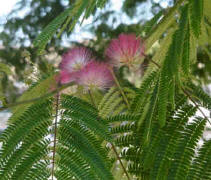 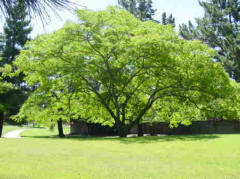 Mimosa Mimosa
Albizia lophantha
NON NATVE
A semi-evergreen 6 meter tree with leaves that
are deep green. The leaves are twice pinnately divided. Native to
Asia. |
 Western Redbud Western Redbud
Cercis occidentalis
NATIVE
Flower is
very showy, light to dark pink in color, 1.3 cm long, appearing in
clusters in March to May before the leaves. Bark is dark in color,
smooth, later scaly with faint ridges. Fruits are flattened, dry,
brown, pea-like pods, 5 to 10 cm long. The flat, elliptical, brown
seeds are 0.64 cm long. Maturing in July to August. |
|
Fagaceae (Oak or Beech Family) |
|
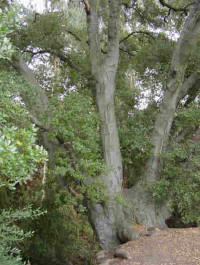 Coast Live Oak Coast Live Oak
Quercus agrifolia
NATIVE
Coast live oak is a tall
tree with smooth gray bark. The 2.5 to 7.6 cm long oval, evergreen
leaves are stiff and leathery and often do not lie flat. They are
shiny dark green on the top surface and dull pale-green below, with
rusty fuzz in the angles formed by the midrib and the side veins and
scattered sharp spines along the edges. The acorn matures in the
first year. The slender, pointed nut is 2.5 to 3.8 cm long.
Mission area
has many old oaks that are over 100 years old. Early pictures of
the area show many oaks lined the Mission Creek. |
|
Hippocastanaceae (Chestnut Family) |
|
California Buckeye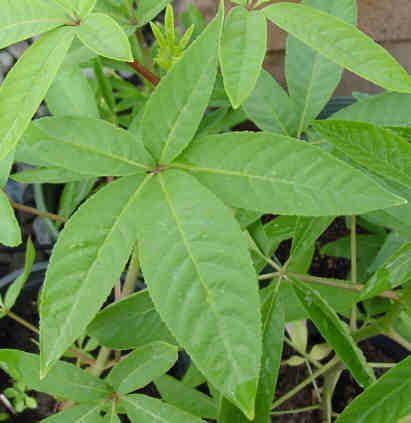
Aesculus california
NATIVE
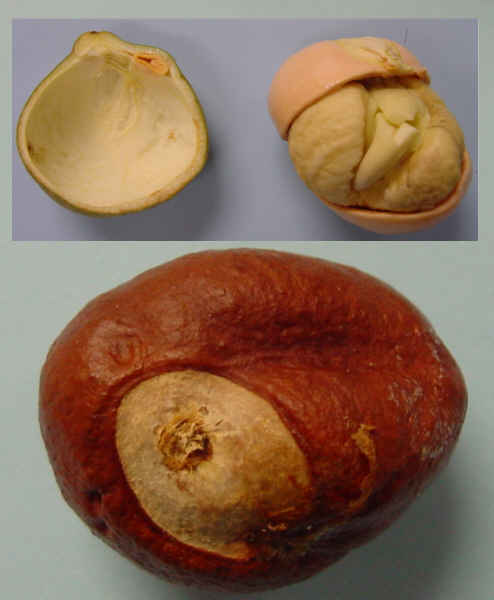 Compound leaf
with 5 leaflets. Flowers bloom in a long, terminal cluster, which
produces a leathery capsule with 1-3 large brown shiny seeds each
with a pale scar (a buck’s eye). Seeds are poisonous to humans. Compound leaf
with 5 leaflets. Flowers bloom in a long, terminal cluster, which
produces a leathery capsule with 1-3 large brown shiny seeds each
with a pale scar (a buck’s eye). Seeds are poisonous to humans.
|
|
Juglandaceae (Walnut Family) |
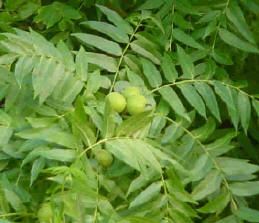 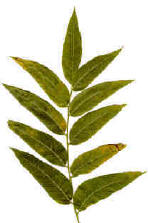 Northern California Black Walnut Northern California Black Walnut
Juglans californica
NATIVE
Northern
California black walnut is a small tree, often branching from near
the ground. The bark is dark brown with deep ridges. The pith is
dark brown. The deciduous compound leaves are 23 to 38 cm long with
11 to 19 slender leaflets. There are soft hairs on the main veins on
the underside of the leaf. The smooth nut has shallow grooves, is
flattened at the ends, and is much smaller and thicker than the
English walnut. It is often found around old Indian encampments in
Central California. It is used as a stock upon which commercially
grown English walnut is grafted because its roots are better adapted
to local soil conditions and may hybridize with this species. |
|
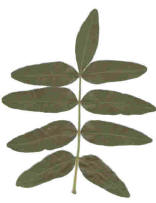 English (Persian)
Walnut English (Persian)
Walnut
Juglans regia
NON NATIVE
English
walnut is native to southeastern Europe, the Himalayas, and China.
It is a large tree with smooth gray bark. The deciduous leaves are
20 to 41 cm long and have 7 to 9 broad leaflets. The end leaflet is
larger than the others. The thin-shelled nut is divided into two
halves. English walnut is often grafted onto California black
walnut rootstock so that it will grow better in local soils. |
|
Lauraceae (Laurel Family) |
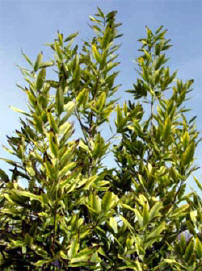 California Bay Laurel California Bay Laurel
Umbellularia californica
NATIVE
This
evergreen bay tree has simple leathery lance-shaped leaves. When
crushed, the pungent leaves smell like bay rum. Bay leaves are
used to season stews and sauces, and are placed on pantry shelves to
discourage insect pests. Clusters of small fragrant yellow flowers
appear in December. The fruit resembles a small avocado and turns
purplish when mature. The heavy, fine-grained laurel wood and burls
are used to make plates, bowls, novelties and furniture and are
often sold as pepperwood or myrtle. |
|
Moraceae (Mulberry Family) |
|
 Edible fig Edible fig
Ficus carica
NON NATIVE
Forms a shrub
or low spreading deciduous tree. Lives in mild winters with hot dry
summers. Originally from Asia. It has large (5-15 cm), simple
leaves with 5 but sometimes 3 or 4 lobes. Bark is smooth, silvery
gray. |
|
Myrtaceae (Myrtle Family) |
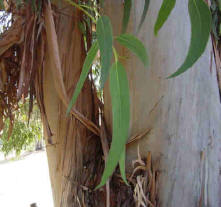 Blue Gum Eucalyptus Blue Gum Eucalyptus
Eucalyptus globulus
NON NATIVE
Blue gum is a
very tall tree that has been planted throughout California. It was
introduced from Australia and Tasmania in the late 1800s as a
fast-growing lumber crop; however, the wood twists as it dries,
making it unsuitable for working. Its roots are very efficient at
finding water at the expense of more desirable native species.
Eucalyptus oil is used in cough and cold medications. The peeling
outer bark ignites readily and firebrands can be carried a great
distance by updrafts produced by fires. |
|
Oleaceae (Olive Family) |
 Oregon ash Oregon ash
Fraxinus
latifolia
NATIVE
Found in
riparian habitats. Tree is dioecious with small greenish flowers
that appear with leaves. Fruits are elliptical samaras that ripen
in late summer. Leaf is compound with 5-9 ovate leaflets. Bark is
thin, smooth and gray green when young. Drought resistant but can
tolerate flooding. |
|
Pinaceae (Pine Family) |
|
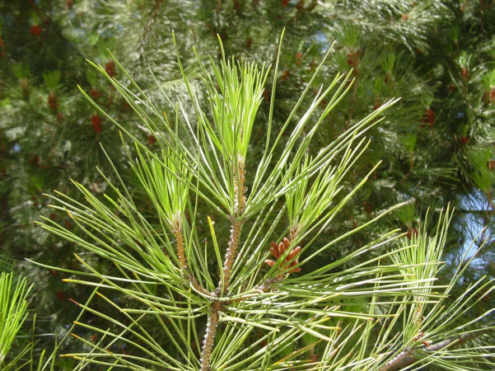 Monterey pine Monterey pine
Pinus radiata
NATIVE (central coastal California)
Trees are
rapid growers and can grow to 15-30 meters. Bark is gray to
red-brown with deep “V” furrows. Needles are long in bunches and
deep yellow-green. |
|
Platanaceae (Sycamore Family) |
|
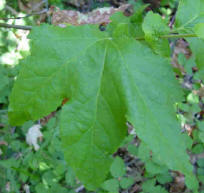 Western Sycamore Western Sycamore
Platanus racemosa
NATIVE
Western
sycamore grows along creek beds. It is a large deciduous tree with
heavy twisted branches. Its “jigsaw puzzle” bark is smooth and
ashy-white with greenish-gray and tan patches. The broad leaves are
light green above and paler and rusty-hairy below. The fruits are
contained in bristly “button-balls” borne in clusters on the flower
stalk. |
|
Salicaceae (Willow and Poplar Family) |
|
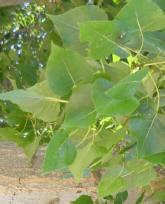 Fremont Cottonwood Fremont Cottonwood
Populus fremontii
NATIVE
Cottonwoods are
common trees found in local creeks within Alameda County. The
deciduous leaves are spade-shaped and become golden in fall. Wind
blowing through the trees sounds like running water. Male and
female flowers are borne on separate trees. The female tree has
cottony seeds that are dispersed by the wind that bloom between
March and April. This tree is well known for its ability to grow
quickly with heights up to 35 meters. |
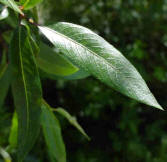 Red Willow Red Willow
Salix laevigata
NATIVERed willow is a medium-sized
deciduous tree that always grows near water. The bark of mature
trees is dark and rough; young twigs may be red to yellow-brown.
The narrow leaves are green and shiny above, whitish below, and
usually widest below the middle. Male and female flowers are borne
on separate plants and appear soon after the leaves in early spring.
The tiny seed produced by the female catkin has a cottony “fluff”
and may be carried a great distance by the wind. Because all
willows root easily and grow quickly, they have potential for
holding soil on steep slopes. The flexible willow shoots were used
by the Ohlone Indians to make baskets and huts. Willow bark contains
salicin, which our bodies convert to salicylic acid, the active
pain-relieving ingredient in aspirin. |
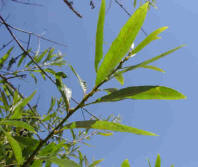 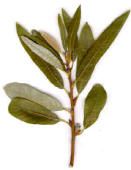 Arroyo Willow Arroyo Willow
Salix lasiolepis
NATIVE
Arroyo willow is
a small tree or branching shrub. It grows along perennial or
summer-dry creeks, or in arroyos. The bark of the mature tree is
deep gray. Twigs are yellowish to brownish. The narrow leaves are
dark green and smooth above and hairy to smooth beneath, with
margins that are sometimes toothed and slightly rolled under. The
leaves are usually wider above the middle. Pliable willow twigs
were used by the Ohlones for making baskets and constructing
temporary huts. Willow bark is a source of salicylic acid, the
active ingredient in aspirin, and was used to relieve pain. |
|
Taxodiaceae (Bald Cypress Family) |
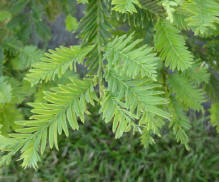 Coast Redwood Coast Redwood
Sequoia sempevirens
NATIVE (Coastal California)This
majestic tree ranges from 60-110 meters tall. Trunks are usually
enlarged with swelling or burls at the base. Cones are small, about
12-35 mm long and reddish brown. |